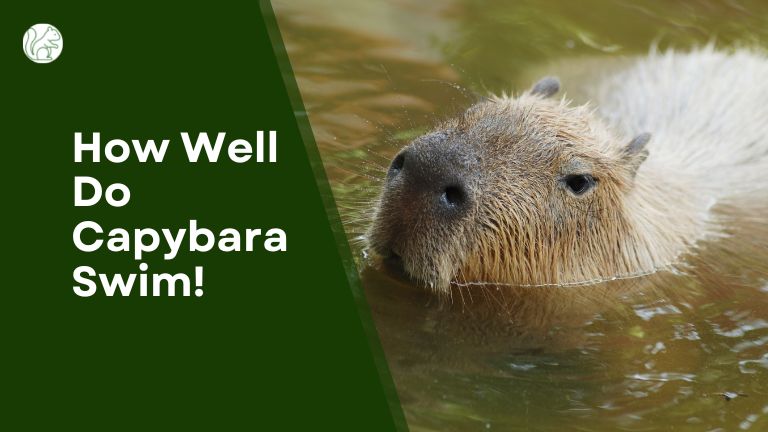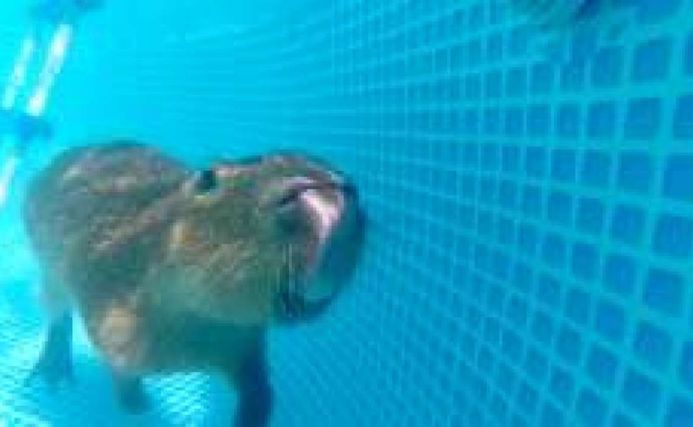From pet keepers to usual folks, a lot of stuff about the tiny and lovely creature called capybara can shock you with its swimming skill.
A capybara swims in water that’s probably 9 feet in length x 16 feet in width with a depth of 4 feet in a pool or small pond. It uses the hands and feet to stroke upward, downward, left, and right sides.
If you are interested to know more about the capybara’s swimming style, speed, duration, breathing, and so on, keep on reading!

Exactly How Do Capybara Swim!
Yes, capybaras can swim in the company of their friend circle or alone. Most of the time, you’ll see them swimming underwater or in a pool alone to get a fresh environment.
The swimming movement of water hogs is close to the blend of freestyle and breaststroke only their hips move a little. All capybaras use their 2 legs nonstop from up to down motion as swimmers do.
Plus, their hands and hip turn in the direction of left and right. The capybaras use their hands to make upstroke and downstroke to enjoy the water and view underneath.
During this, the water hog lifts its nose, eyes, and upper face to see the path while the rest of the body stays under the water. Sometimes it goes under the water and roams there for a while.
Can A Capybara Swim in A Chlorinated Pool?

It’s a bad idea to let the creature swim in a chlorinated pool. In that kind of pool, the main element that makes the water harmful to animals including water hog is chlorine dioxide. Here are a few reasons why you should never let it swim in the chlorinated pool.
- The high level of chlorine in the water pool will make the body of the capybara weak and cause minor GI irritation.
- It can irritate the eyes, nose, and ears if the water hog goes underwater.
- Water hog swims for a pretty long period and sometimes gets tired due to movement. As the pool water contains chlorine, water hog can drink water from it when feeling restless. This causes loss of appetite and blood to flow from the nose of the capybara.
- A lot of time the chlorine in the water can kill good bacteria like micro-organisms from the water hog body. This kind of bacteria helps animals to digest food easily.
- According to CDC (Centers for Disease Control and Prevention), wildlife including the capybara in a chlorinated pool can kill animals if the level of chlorine is more than 0.5 gm/L.
How Fast Can Capybara Swim!
Not only does it run fast (35 mph) on the land, but the water hog’s swimming speed is also incredible in the water.
Being a pro-like swimmer, the capybara swim speed is around 22 mph (miles per hour) or 35.41 Km/h (kilometer per hour). The swimming speed of capybara is close to alligators and penguins.
It uses 2 wedded feet and hands to maintain the rapidity in the water. The water hog controls the speed range using the arm even if the weight is above 77 – 145 lbs.
How Long Can a Capybara Swim?
Naturally, most water hogs will swim for up to 10 – 30 minutes or more in order to feel the cooling sensation in the body and relax.
There’s no fixed duration of the swimming period for the water hog. Based on the energy, some capybaras can swim for 1 hour too. Its fur contains a lot of ticks, mites, and other fleas that bite a lot.
To get rid of these creature bites and feel good mentally, the water hog will go underwater to swim for several minutes.
Can Capybara Breathe Underwater?
Well, the capybara can hold their breath underwater thanks to breathing skills. You see, the creature uses its nostrils to do a quick inhale before going underwater. And it exhales underwater to stay there for a long period.
In usual cases, the water hog stays under the water for up to 2 to 5 minutes without taking a breath. However, if it feels tired or weak for some reason, it might not stay long enough to hold its breath.
Overall Thoughts
Seeing the tiny to adult capybara swim on the water is a fun thing to watch. It moves smoothly and shows its swimming skill using its tiny feet and hands. If it’s your pet, be careful about its swimming zone as it can drown if the pool depth is above 4”.
Just ensure everything before you let it go underwater. Hope this helps you with the needed details and I’ll be back with a new topic soon. Bye!
